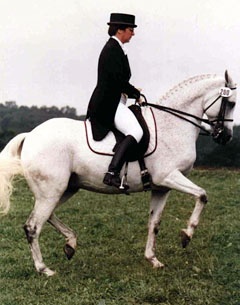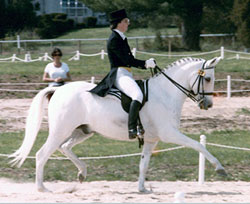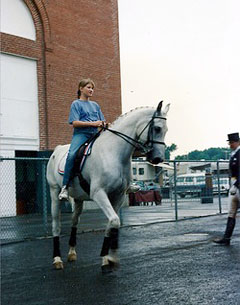
They were bred to race, pull a carriage or plough, but thanks to their limitless will to work and people believing in them they ended up reaching the highest levels of competitive dressage, the Grand Prix. Being bred for generations to do anything but dressage, their training required not only skill and patience, but determination and belief. The reward of going international with such a horse is often encouraged by crowds’ liking as these "against the odds" star horses reflect a remarkable, hard fought journey to the highest echelons of dressage.
Eurodressage will be starting a new series of articles in which "exotic" horses defied the odds.
Seldom Seen, a Connemara Crossbred Going All the Way
When it comes to promoting exotics in dressage the Brits seems to lead. One can see crossbreds of their native ponies with thoroughbreds at Grand Prix level for decades, such as the Welsh Cob crossbred Okeden Yeoman or the Connemara crossbred Little Model who finished 11th in the 1960 Olympic Games with Brenda Williams and earned a bronze medal in the 1961 unofficial European championships at Aachen.
The Connemara pony is the only native breed of Ireland and is popular all around the world. The height varies between 140 and 150 cm and the colours mostly seen are grey, dun and bay. The Connemara is well known for its versatility and it’s quite common to cross it with thoroughbreds to get bigger and more athletic horses with the cleverness of the pony and the abilities of a horse. Two of these crossbreds, Dundrum and Stroller, excelled at the highest levels of jumping with Stroller being the only pony so far winning an Olympic medal, individual silver in 1968.
Probably the most popular crossbred of our times has been Lendon Gray’s remarkable Connemara x thoroughbred Seldom Seen which represented the United States on a tour in Europe in the 1980s, when he became the crowd favourite galloping some metres behind the big warmbloods in the prize givings.
Standing 14,2 hh this small horse with rather average movements lived up to his name Seldom Seen through his dressage training. The grey gelding was bred by Peggy Whitehurst in Alabama with the intention to get a nice Pony Club horse for her daughter. Whitehurst bred her Connemara mare to a New Zealand thoroughbred named Mitipo, which only acted as a teasing stallion on her stud. Seldom Seen remained his only offspring.
The dapple grey gelding met Lendon for the first time in 1975 when she worked for Whitehurst, breaking in her young horses. As Whitehurst’s daughter wasn’t competing anymore Peggy asked Lendon to start Seldom Seen in novice eventing in which he did extremely well, winning all events. When the Maine based Lendon returned the next winter Peggy suggested showing him in dressage and she competed him in Alabama at first level. Although now an accomplished Olympic dressage rider and trainer, Gray was at at the time at the very beginning of her dressage career and she and the diminutive gelding learnt the ropes together.
Seldom Seen was not only very small, but also far from being a spectacular mover so there was not much encouragement from people for Lendon to try advancing this pony. One of the few who did boost Lendon's morale was Hilda Gurney, the 1976 bronze medal winner in dressage who said she would have loved getting Seldom Seen to train him to Grand Prix-level.
”When I was bringing on Seldom Seen, hewas the very first horse I trained from novice to Grand Prix. I got constant support from Michael Poulin. He was one of the very few people to believe there was value in training him. Many, many people told me that it would be very bad for my reputation as a dressage rider to ride such a pony," Gray reminisced.
The training itself held no particular problems because "Seldom Seen was an incredibly kind and generous horse. Many times I trained something a wrong way and had go back and fix it. You could almost hear him sigh and say ‘how do you want me to do it now?’ He was a bit lazy, but never negative. The hardest thing for him to do were the Grand Prix half passes. His short legs didn’t cover much ground sideways and he didn’t have much suspension to his trot. He also spooked a great deal at home – there would be one spot in the arena, or a jump standard or something that he could not go by without losing his attention – that drove me nuts because there was no reason for it. At shows his attention was always on me."
Lendon trained Seldom Seen not with the goal of making him a Grand Prix horse, but rather in an attempt to improve him and see how far they could get. "When I got to the FEI levels and there started to be resistance to us it just made Michael and me want to do it even more," Gray told Eurodressage.
Facing Criticism
Whereas Michael Poulin believed in his student’s small horse, other trainers did not want to teach Lendon on a “pony”. When both went over to Europe after having raised the money to fly over, they spent an amazing three weeks at Herbert Rehbein who loved Seldom Seen. Also Georg Wahl, with whom Lendon did a clinic, liked the pony very much. "Both were the only trainers who took Seldom Seen seriously. One very top European trainer and Olympic rider wouldn’t give me a lesson on him," Lendon admitted.
 When Lendon and her pony reached the FEI levels and started to compete at Prix St. Georges the unusual pair began to drew a lot of attention, "bad and good." There were Seldom Seen fans whose amount grew steadily. People just love the “outsider” image because these horses were not bred for dressage and try so hard for their rider. Spectators felt strongly encouraged by the success of an “ordinary” and moreover small horse like Seldom Seen.
When Lendon and her pony reached the FEI levels and started to compete at Prix St. Georges the unusual pair began to drew a lot of attention, "bad and good." There were Seldom Seen fans whose amount grew steadily. People just love the “outsider” image because these horses were not bred for dressage and try so hard for their rider. Spectators felt strongly encouraged by the success of an “ordinary” and moreover small horse like Seldom Seen.
"This was the time that people started to flock to Europe to buy big fancy warmbloods. The average American couldn’t afford to do that, so these people loved to see the "pony" with average gaits do so well. He proved what good training could accomplish. To this day I get letters form people lots of others were saying that Seeing Seldom Seen gave them a boost to go home and work harder on their own unimpressive dressage horse," Lendon reported.
The growing sympathy amongst onlookers was the positive side of competing a small horse so different from the others. The rather negative one was that not all judges cherished what Lendon had accomplished with Seldom Seen. A pony-sized dressage horse was something seldom to be seen indeed and some judges just couldn’t get their eyes used to this sight and adjusted their judging to it, a trend very recognizable in the 1990s when the first Iberian horses started internationally.
"There were often discouraging comments from judges and the common comment was that Seldom Seen didn’t cover enough ground. An interested physicist once studied his stride compared to the top US Olympic horse at the time and SS’s stride was slightly longer than that horse in relation to his height. We often got scores lower than we deserved, but also many times got scores we did deserve.”
Apart from the judges also not every competitor loved to see a pony do so well and be beaten by a it: "People with their fancy expensive warmbloods from Europe just didn’t like being beaten by a kid from Maine with her pony," Lendon confessed.
Seldom Seen at Grand Prix Level
When Seldom Seem moved up to Grand Prix level he continued to do very well, earning victories and many placings in the USA. While the lovely Connemara crossbred was short-listed annually during his Grand Prix career, the United States Equestrian Team (USET) would have never allowed him to be on a US team representing the country in which has was born. "The people of the USET said it publicly and used as an excuse that the European judges wouldn’t accept him. So Peggy and I did some major fund raising and took Seldom Seen to Europe by ourselves," said Lendon.
Competing in Europe was a remarkable experience for Lendon and she found out that the European judges did her horse justice. "They were a bit surprised to see him, but scored him more fairly than the American judges. This still didn’t convince the USET powers,” Lendon regretted.
However hard the odds had been both faced them with resilience throughout their long career which lasted until Seldom Seen’s 17th birthday. Both looked back on an extraordinary career that gave the sport much more than any talented warmblood had probably been able to give at the time: Seldom Seen was a masterpiece of what dressage training could do with horses neither bred for the job nor having the usual size. He won up to Grand Prix, even the prestigious Grand Prix class in Devon and earned some placings on his European tour.
 When the crowd favourite said farewell in a freestyle for his retirement ceremony at Devon in 1987 he was sound as a bell and remained so until almost the end. After his retirement Lendon showed him for some years in exhibitions of which the one together with a reining horse was in particularly successful.
When the crowd favourite said farewell in a freestyle for his retirement ceremony at Devon in 1987 he was sound as a bell and remained so until almost the end. After his retirement Lendon showed him for some years in exhibitions of which the one together with a reining horse was in particularly successful.
The last years Seldom Seen went trail riding with one of Lendon’s clients before this great old campaigner had to be put down at the grand age of 26 in 1996.
Almost 16 years have gone by since, but Seldom Seen remains a legend many have fond memories of. The USDF inducted him in their Hall of Fame in 2005: "In recognition of his outstanding service as an ambassador for the sport of dressage, proving that a very small horse of common breeding can compete against the best in the country."
For Lendon, who competed another Connemara crossbred called Last Scene, dressage had always been there as a tool to improve any horse. It was nothing different with Seldom Seen.
"You had to put the 'pony prejudice' behind you and just move on. I showed him because I loved riding him, I was proud of the training I had done, and when I went in the ring I knew if we had done our best, if the judges like it, it made me happy. If the judges didn’t Seldom Seen still made me happy."
Text by Silke Rottermann
Photos © USDF
Related Links
Lendon Gray Announced as 2011 Roemer Foundation/USDF Hall of Fame Inductee
Balagur Taking the Orlov Trotter into the 21st Century